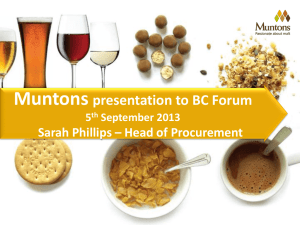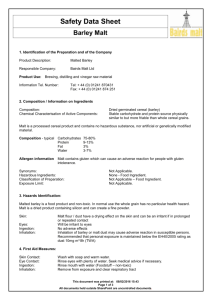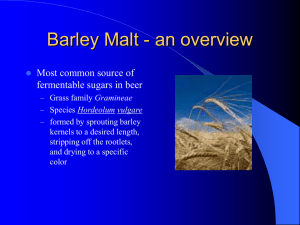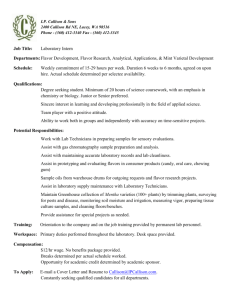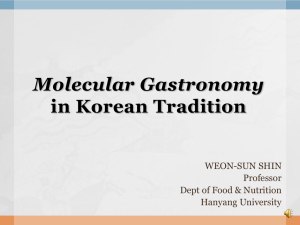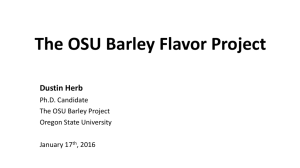May 2015 Flavor Report
advertisement
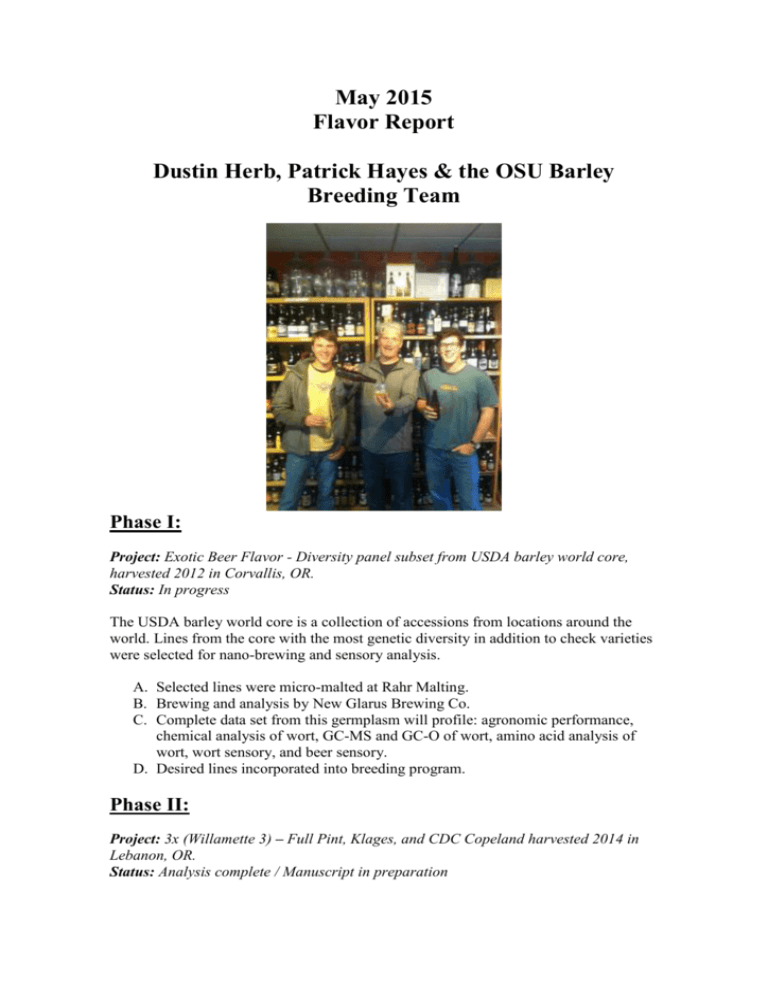
May 2015 Flavor Report Dustin Herb, Patrick Hayes & the OSU Barley Breeding Team Phase I: Project: Exotic Beer Flavor - Diversity panel subset from USDA barley world core, harvested 2012 in Corvallis, OR. Status: In progress The USDA barley world core is a collection of accessions from locations around the world. Lines from the core with the most genetic diversity in addition to check varieties were selected for nano-brewing and sensory analysis. A. Selected lines were micro-malted at Rahr Malting. B. Brewing and analysis by New Glarus Brewing Co. C. Complete data set from this germplasm will profile: agronomic performance, chemical analysis of wort, GC-MS and GC-O of wort, amino acid analysis of wort, wort sensory, and beer sensory. D. Desired lines incorporated into breeding program. Phase II: Project: 3x (Willamette 3) – Full Pint, Klages, and CDC Copeland harvested 2014 in Lebanon, OR. Status: Analysis complete / Manuscript in preparation The Willamette 3 project assesses flavor differences between varieties: one industry standard, one craft standard, and one heirloom. These three varieties were grown on the Herb Farm in Lebanon, OR in 2014 then malted at the Canadian Malting Barley Technical Center (CMBTC). 1st run malt (30 lbs pale malt) was sent to New Glarus Brewing Co. to brew a lager, and the adjusted 2nd run malt (30 lbs pale malt) was sent to Sierra Nevada Brewing Co. to brew a pale ale. Both beers were approximately 15 gals. A. Sensory analysis completed. 1. Data set compiled of sensory results from taste tests at New Glarus Brewing Co. (NGBC), Sierra Nevada Brewing Co. (SNBC), Barley Improvement Conference, Oregon State University, and a local brewing supply shop (Corvallis Brewing Supply). B. Variety effect was significant: 1. Difference testing: Klages was significantly different from Full Pint and Copeland at SNBC. Copeland was significantly different from Klages and Full Pint at NGBC. 2. Descriptive analysis: Across breweries Full Pint had more complex flavors including malty, nutty, and toffee aromas. Copeland had higher astringency and better mouthfeel. Klages was bland and watery, but deemed crisper than other beers. Beer preference varied among panelists. 3. High buttery flavor detected in two beer samples. Diacetyl testing pending. Project: 3x3 – Full Pint, Klages, and AC Metcalfe harvested 2013 in Corvallis, OR, St. Paul, MN, and Saskatoon, SK, CA. Status: Manuscript / ASBC presentation The 3x3 project assesses the varietal, environmental, and genotype x environment (GxE) effects on flavor. Three varieties grown in replication in Oregon, Minnesota, and Canada harvested in 2013 and malted by Rahr. Samples sent to Sierra Nevada Brewing Co. for wort sensory, GC-MS and GC-O analysis. A. Significant varietal and environmental effects on specific flavor attributes for both aroma compounds (Figure 1) and palette sensory evaluations (Figure 2). 1. Full Pint highest in malt aromas 2. Metcalfe highest in fruity aromas 3. Klages highest in basic taste B. Environment (location, nutrients, moisture, temperatures, and daylength) and variety interactions may play a role in flavor type and intensity (Figures 3 & 4). 1. Minnesota highest in fruity and dirty aromas 2. Oregon highest in malt, dairy, and chemical aromas 3. Saskatoon highest in basic taste C. More research needed to know the extent of effect and/or optimal management strategies to enhance flavor. Figure 1. Aroma Compound Flavor Wheel for Varieties and Environments TASTE 40000.00 TOTAL MALT 30000.00 20000.00 CHEMICAL FRUITY 10000.00 0.00 DAIRY TOFFEE VEGETABLE WOODY CHOCOLATE FP MN FP OR FP SK KG MN KG SK MC MN MC OR MC SK KG OR Figure 2. Sensory Assessment Flavor Wheel for Varieties and Environments TASTE 14 TOTAL TOFFEE 12 10 8 OTHER MALT 6 4 2 DIRTY FRUITY 0 CHEMICAL VEGETABLE CHOCLATE WOODY DAIRY FP MN FP OR FP SK KG MN KG SK MC MN MC OR MC SK KG OR Figure 3. Biplot analysis of flavor differences between varieties. Figure 4. Biplot analysis of flavor differences between environments. Project: Barley vs. Malt – 2014 harvested CDC Copeland grain and malt from Great Western Malting Co. in Vancouver, WA. Status: Analysis The Barley vs. Malt project assesses the effect of malting on aroma compounds inherent in barley grain. Unblended barley and malt were sourced from the same farm and lot (donated by Great Western Malting Co.) and then brewed to identical recipes with 100% grist bills of both the barley and malt, with the only difference being the use of Ondea Pro enzyme cocktail from Novozymes. Control samples determined baseline flavors for both brews. Beers were evaluated by the OSU brewing lab under the direction of Dr. Tom Shellhammer. A. Flavor of the barley beer with enzymes differed substantially from that of the malt beer. B. Sensory evaluations indicate that the barley beer was fruitier, smoother, and had a crisper mouthfeel, but that it lacked body. The malt beer had nice well-rounded flavor consisting of more malty and nutty aromas. However, it had a boozy/ethanol taste finish. C. GC-MS and GC-O analysis will be performed on both beers as well as controls to separate malting effects from flavors originally present in barley and carried over through all malting/brewing steps. Phase III: Project: Oregon Promise (Full Pint x Golden Promise); Maris Beaver (Full Pint x Maris Otter); Full Stein (Full Pint x Violetta) pop’n. Status: In Progress The Oregon Promise, Maris Beaver, and Full Stein genetic mapping populations were created to integrate flavors from well-known heirloom varieties into the adaptation and flavors from the OSU variety Full Pint. In addition the Full Stein population will be selected for facultative growth habit. A. Selections from all populations were planted in 3 OR locations: Corvallis, Lebanon, and Madras. B. Plots look good and have begun to flower. Agronomic notes will be taken and evaluated for advancement. C. Selections from the Oregon promise population have been malted (thanks to the Cereal Crops Research Unit) and sent to New Glarus Brewing Co. for nanobrew and sensory. D. Flavor analysis on top lines coming News: A. Craft Brewing Conference was successful for Dustin and Scott. Lots of networking and ideas for the future of barley contributions to beer flavor. B. Craft Maltsters Guild tour of the OSU Barley Breeding Program was informative, with positive feedback C. Barley flavor to be presented on June 15th at the ASBC in La Quinta, CA. If you are going to the conference, please come by and show support for the project! D. Barleyworld & OSU Brewing Lab will be testing a pico-brew system from Picobrew in Seattle, WA (http://www.picobrew.com). Any ideas for what to brew that will enhance the flavor project? 1. Full Pint malt? Alba malt? Enzyme beer? Suggestions? E. OSU Fermentation Science granted $1 million to upgrade brewing equipment and teaching facilities. F. Construction on OSU malt lab has begun, and the OSU mini-malter is coming home this fall! G. AMBA funding for the development of winter/facultative doubled haploids from crosses of the most low temperature tolerant barley in the world (that we have found) by 2-row barley with good malt quality. 1. Tentative selections have been made for crossing this year! H. Congratulations to Paul Sadosky on his new job with MillerCoors flavor division. ***As always there is a standing invitation to come visit Barleyworld at anytime*** Thank you for your continuous support
